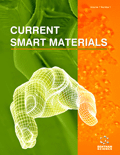[1]
Li, B.; Zhou, D.; Han, Y. Assembly and phase transitions of colloidal crystals. Nat. Rev. Mater., 2016, 1, 15011.
[2]
Jiang, S.; Van Dyk, A.; Maurice, A.; Bohling, J.; Fasano, D.; Brownell, S. Design colloidal particle morphology and self-assembly for coating applications. Chem. Soc. Rev., 2017, 46, 3792-3807.
[3]
Armstrong, E.; O’Dwyer, C. Artificial opal photonic crystals and inverse opal structures-fundamentals and applications from optics to energy storage. J. Mater. Chem. C, 2015, 3, 6109-6143.
[4]
Pusey, P.N.; Van Megen, W.; Bartlett, P.; Ackerson, B.J.; Rarity, J.G.; Underwood, S.M. Structure of crystals of hard colloidal spheres. Phys. Rev. Lett., 1989, 63, 2753-2756.
[5]
Koumakis, N.; Brady, J.F.; Petekidis, G. Amorphous and ordered states of concentrated hard spheres under oscillatory shear. J. Non-Newt. Fluid Mech., 2016, 233, 119-132.
[6]
Pusey, P.N.; Van Megen, W. Phase behaviour of concentrated suspensions of nearly hard colloidal spheres. Nature, 1986, 320, 340-342.
[7]
Pham, K.N.; Puertas, A.M.; Bergenholtz, J.; Egelhaaf, S.U.; Moussaïd, A.; Pusey, P.N.; Schoefiled, A.B.; Cates, M.E.; Fuchs, M.; Poon, W.C.K. Multiple glassy states in a simple model system. Science, 2002, 296, 104-106.
[8]
Min, Y.; Akbulut, M.; Kristiansen, K.; Golan, Y.; Israechvili, J. The role of inter particle and external forces in nanoparticle assembly. Nat. Mater., 2008, 7, 527-538.
[9]
Exner, H.E.; Müller, C. Particle rearangement and pore space coarsening during solid-state sintering. J. Am. Ceram. Soc., 2009, 92, 1384-1390.
[10]
Tadmor, R.; Rosensweig, T.R.; Frey, E.; Klein, J. Resolving the puzzle of ferrofluid dispersants. Langmuir, 2000, 16, 9117-9120.
[11]
Mackor, E.L. A theoretical approach of the colloidal-chemical stability of dispersions in hydrocarbons. J. Colloid Interface Sci., 1951, 6, 492.
[12]
Kramer, T.M.; Lang, F.F. Colloidal processing of silicon nitride: Rheology of alkylated powders. J. Am. Ceram. Soc., 1994, 77, 922-928.
[13]
Benitez, J.J.; Kopta, S.; Diez-Perez, I.; Sanz, F.; Ogletree, D.F.; Salmeron, M. Molecular packing changes of octadecylamine monolayers on mica induced by pressure and humidity. Langmuir, 2003, 19, 762-765.
[14]
Velamakanni, B.V.; Chang, J.C.; Lange, F.F.; Pearson, D.S. New method for efficient colloidal particle packing via modulation of repulsive lubricating hydration force. Langmuir, 1990, 6, 1323-1325.
[15]
Hamaker, H.C. The London-van der Waals attraction between spherical particles. Physica, 1973, 4, 1058-1072.
[16]
Bergström, L.; Meurk, A.; Arwin, H.; Rowcliffe, D.J. Estimation of Hamaker constants of ceramic materials from optical data using Lifshitz theory. J. Am. Ceram. Soc., 1996, 79, 330-348.
[17]
Dakskobler, A.; Kosmač, T. Rheological properties of re-melted paraffin-wax suspensions used for LPIM. J. Eur. Ceram. Soc., 2009, 29, 1831-1836.
[18]
Zhou, Z.; Solomon, M.J.; Scales, P.; Boger, D.V. The yield stress of concentrated flocculated suspensions of size distributed particles. J. Rheol., 1999, 43, 651-671.
[19]
Buscall, R.; McGowan, I.J.; Mills, P.D.A.; Stewart, R.F.; Sutton, D.; White, L.R.; Yates, G.E. The rheology of strongly flocculated suspensions. J. Non-Newt. Fluid Mech., 1987, 24, 183-202.
[20]
German, R.M. Powder Injection Molding; Metal Powder Industries Federation: Princeton, NJ, 1990, pp. 147-172.
[21]
Flatt, R.J.; Bowen, P. A yield stress model for suspensions. J. Am. Ceram. Soc., 2006, 89, 1244-1256.
[22]
Flatt, R.J.; Bowen, P. Yield stress of multimodal powder suspensions: An extension of the YODEL (Yield Stress mODEL). J. Am. Ceram. Soc., 2007, 90, 1038-1044.
[23]
Dakskobler, A.; Kocjan, A.; Bowen, P. Predicting the yield stress of paraffin-wax suspensions. Powder Technol., 2016, 291, 1-6.
[24]
Dullien, F.A.L. Porous Media. Fluid Transport and Pore Structure, 2nd ed; Academic Press Inc., 1992.
[25]
Franks, G.V.; Lange, F.F. Plastic-to-brittle transition of saturated, alumina powder compacts. J. Am. Ceram. Soc., 1996, 79, 3161-3168.
[26]
Panine, P.; Narayanan, T.; Vermant, J.; Mewis, J. Structure and rehology during shear-induced crystallization of a latex suspension. Phys. Rev. E, 2002, 66, 022401.
[27]
Wu, Y.L.; Derks, D.; Van Blaaderen, A.; Imhof, A. Melting and crystallization of colloidal hard-sphere suspensions under shear. Proc. Natl. Acad. Sci., 2009, 106, 10564-10569.
[28]
Seager, C.R.; Mason, T.G. Slippery diffusion-limited aggregation. Phys. Rev. E, 2007, 75, 011406.
[29]
Millet, P.C.; Wang, Y.U. Diffuse interface field approach to modeling and simulation of self-assembly of charged colloidal particles of various shapes and sizes. Acta Mater., 2009, 57, 3101-3109.
[30]
Kramb, R.C.; Ward, L.T.; Jensen, K.E.; Vaia, R.A.; Miracle, D.B. Structural property comparison of Ca-Mg-Zn glasses to a colloidal proxy system. Acta Mater., 2013, 61, 6911-6917.
 20
20 6
6





